Tammy Lowe's Blog, page 3
September 24, 2023
Story Time...
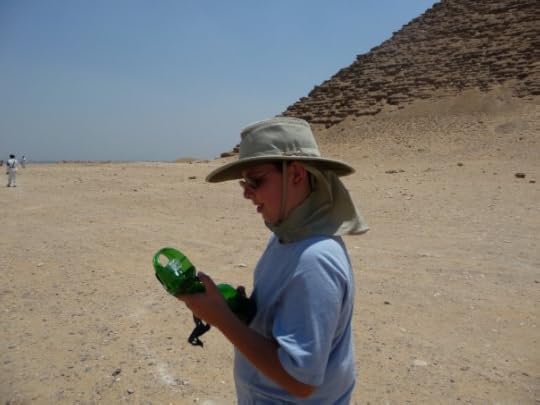
We're in this van in Cairo, with Rasha, an Egyptologist. She studied under famed Zahi Hawass himself, Egypt's former Minister of Antiquities.
But, we get into a wreck leaving Cairo. Someone sideswipes the van. There's a bit of yelling and hand gestures from our driver.
"Is everything okay?" my husband, Gord, asks.
In the passenger seat, Rasha turns around. "They hit us and didn't even say sorry."
Oh!
That's it. Everyone drives on like nothing happened.
Beep. Beep. Motorcycle drives by- guy carrying enormous rolled up carpet on his shoulder.
Beep. Beep. Next motorcycle has entire family- dad, mom, two kids...and the family dog.
I'm mesmerized by the scene outside as we continue on.
We're heading to Dashur, passing through the "modern" city of Memphis. It looks straight out of an Indiana Jones movie-- complete with entire cow and pig carcasses hanging from market stands in the street.
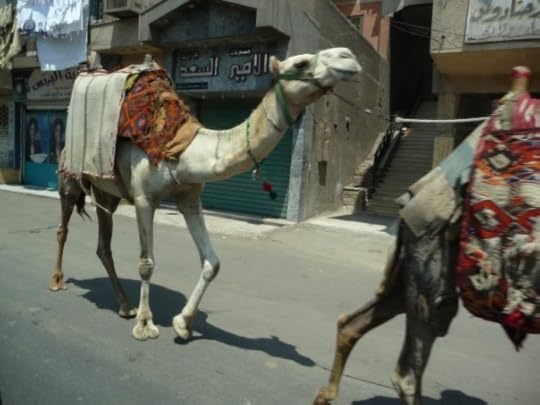
Our driver eventually stops. We are in the middle of nowhere. Sand everywhere you look, but there are two pyramids here. We're at the base of the Red Pyramid, and in the distance is the Bent Pyramid.

You immediately see how the Bent Pyramid got its name. The top is bent.
"Bent Pyramid is second one built," Rasha explains. "They measure wrong. Pharoah didn't use it."
So, while she's telling us about the pyramid, a bunch of armed police officers come over. Rasha and our driver walk off a few feet away with them and they all get into a VERY heated discussion.
Gord and I are staring at each other wide-eyed, but we think we have a clue to what's going on since we've already had several "encounters" with them.
They want "baksheesh" from us.
As predicted, Rasha pulls out her wallet and hands them "baksheesh" so they'll leave us alone.
"Is everything okay?" we ask when she walks back.
"Oh yeah. Everything fine," she lies.
But...the guards walk away and leave us alone to explore. (You can kind of see some of them walking away in the first photo)
Looking at the pyramid, it might not seem like much, but to get all they way up to the entrance is actually quite a hike. It's a steep uphill walk to the base of the pyramid, then up another 92 feet of ancient stones, all under a relentless desert sun.

Once inside, it's a steep 200 feet down.
Walking backwards.
Hunched over.
In the dark.
But, we are all exited when we get to the bottom. I say to Gord, "Can you believe we are standing INSIDE a pyramid in Egypt?"
The thing I remember most? The smell.
It smelled of about two thousand years of urine. Apparently, any guards who climbed down there and had to go potty didn't want to climb back out.
We eventually leave and head back to Cairo. We're staying at The Four Seasons on the Nile. To get into the hotel itself is something else. The van drives up to a guard shack, stopping at the huge metal barricades.
Armed hotel guards with guns surround our vehicle. One talks to our driver and checks all our IDs and Passports. Meanwhile, a German Shepherd is sniffing our car...as it's also being checked underneath for bombs.
Cleared to proceed, the metal barricades lower and we are driven up to the front entrance. It's starting to feel like the Four Seasons again here. We settle last minute plans with Rasha for the next day and say goodbye.
Now, to get into the lobby of the hotel, we pass through airport grade metal detectors and armed guards once again.
Luxor felt safer, but in Cairo...I didn't want to leave the hotel property on our own for anything.
September 23, 2023
Interesting Fact of the Day...
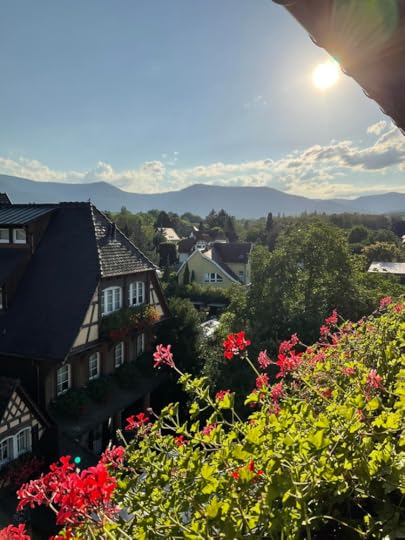
I recently stayed in the picturesque Alsace region of France. Every town looked straight out of a fairytale. While visiting Strasbourg, I was reminded of the fascinating tale of...
THE DANCING PLAGUE OF 1518
In what is now France, in the city of Strasbourg, Frau Troffea stepped out of her house one July morning and began to dance. People walking by laughed at first, but the woman couldn’t stop. It went on for days. She’d collapse from exhaustion, her feet bloody and raw, but she’d get back up and continue dancing. Eyewitnesses say Frau Troffea was not having convulsions -she was dancing. Within a week, at least thirty more people danced in the streets of Strasbourg, unable to stop. By August, there were nearly four hundred people dancing non-stop. Many died from exhaustion or heart attacks on the spot while horrified onlookers watched, unable to help.
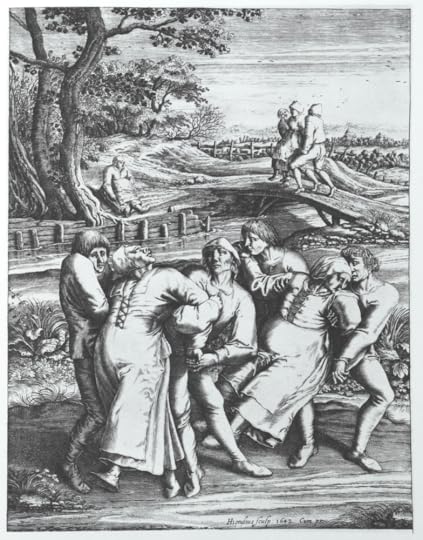
Die Wallfahrt der Fallsuechtigen nach Meulebeeck (1564) by Pieter Bruegel
The townsfolk not afflicted with the disease were bewildered. Doctors decided that the cause must be “hot blood” and the prescription was…more dancing so the sickness could run its course. Stages were built, guild halls were taken over, musicians were hired, and more dancing was encouraged. However, it was an epic failure as this caused the dancing plague to spread.
Experts say an Olympian today would not have been able to maintain the amount of dancing these people did. Additionally, at this particular time in history, there were food shortages. Villagers would never have had the stamina to dance non-stop for weeks.
Then, one day it stopped as mysteriously as it had started. Those who survived the dancing plague went back to their homes.
There are several theories as to the cause, from a fungus growing on their rye bread to mass hysteria. Although it is well documented, no one really knows why this happened in Strasbourg 500 years ago.
September 22, 2023
Story Time...

I have a story that has become a family classic.
Christmas Day. 1992.
I'm 21 years old.
My husband, (then boyfriend) Gord, and I get back home after all the festivities. I'm super excited because we have tickets to see The Nutcracker the next evening in Toronto.
I have an old Henna hair treatment sitting around in a box.
You know...those "all natural" hair dyes? It adds volume to my thin locks and I've used them numerous times.
So, clearly it's the perfect time to give my hair a Henna treatment. I imagine having a head of luscious brown waves for the ballet.
I put the Henna on and when it's time to rinse it out, I'm leaning over the side of the tub, watching the water come out blue-ish.
Weird.
But I keep rinsing and rinsing, noticing my hair itself is actually...sort of...green.
Now, panic is starting to kick in.
I grab some shampoo and scrub my head.
My hair is completely green.
I'm not talking a slight green "tinge". I'm talking full on seaweed green. The colour of spinach.
I swear, I must have washed my hair ten times. It was not coming out.
So, I start bawling my eyes out. (hahahahaha)
Gord is standing there...trying not to laugh.
Needing more sympathy, I call my brother, James.
"My hair is greeeeeeeen," I start wailing into the phone.
Silence.
Then James starts laughing hysterically.
I'm still bawling my eyes out, telling him this isn't supposed to happen in real life. "This kind of stuff only happens in books and movies. Whaaaaaaaaa."
Gord eventually calms me down. "Don't worry. We will get you into a hairdresser first thing tomorrow morning and they can fix it."
I'm thinking they're going to have to chop my long hair right off, a la Anne Shirley.
The next morning, Gord wakes up and starts phoning every hair salon in the city. Most aren't even open since it's Boxing Day. He finally finds someone open and willing to tackle my green hair.
So, I crawl out of bed, eyes puffy from crying all night, and head to the hairdresser. When I get there, I take off my baseball cap, and they gasp.
"Yeah...it's GREEN all right," everyone says in amazement, circling me like I'm a circus freak.
The guy dyes my hair the brightest red you can imagine. "It's to neutralize the green," he tells me.
Okay. I guess bright red hair is better than green.
But, to my relief, he then dyes it dark brown over top to cover the red.
I left the salon relieved. I actually looked normal. The man was a miracle worker.
However...about six weeks later, when the hair dye wore off, my hair began to turn green again.
That's right!
The henna had literally turned my hair green...for good.
Just like when nature turns your hair grey, I'd inadvertently helped nature turn my hair green.
It took many, many, many years, but my green hair eventually grew out.
I see old photos, like this one, and the first thing I do is check my hair-- to see if I can spot any of the lovely spinach green shade.
Nowadays, whenever I complain about having to constantly colour greying hair, I just remind myself... it's NOTHING compared to having to colour green hair.
And there you have it. The decade I spent with green hair.
September 21, 2023
Interesting Fact of the Day...

Kijongdong, North Korea
Grab a cup of afternoon tea. Today I'm going to take you to Kijongdong, North Korea.
But first, let me tell you about Daeseong-dong.
On the border between North and South Korea, on either side of the demilitarized zone, are two villages:
Kijongdong in the North.
Daesong-dong in the South.
To live in South Korea's Daesong-dong would be nerve-wracking. With no peace treaty ever signed, the two nations are still technically at war. Your backyard consists of a heavily armed border with the North Korean, South Korean, and U.S. militaries. The tension is so strong here you can feel it in the air.
To live in Daesong-dong you must be born here, or marry someone born here.
"But Tammy, why on Earth would anyone want to live here?" I bet you're thinking.
Well, the village is mostly inhabited by farmers. They are not only given huge plots of land on which to farm, they also receive a guaranteed income of approx. $100,000 US dollars. (equivalent)...and do not have to pay taxes. The school here receives more funding than any other. But, while the villagers are amongst the wealthiest in South Korea, they have strict rules to keep them safe, including the fact they must be home by 11:00 every night for a head count.
The village in North Korea--Kijongdong, would blast messages from loud speakers so the villagers in Daesong-dong could hear it:
"Come over to wonderful North Korea."
"Come to paradise."
"We are the land of milk and honey!"
North Korea would blast all sorts of propaganda, attempting to lure disgruntled villagers across the border.
It didn't work. Instead, the South Koreans erected walls of speakers, blasting K-Pop music that could be heard up to 24 km away...as well as world news not-available to North Koreans.
Furious, Kim Jong-Un threated to blow the speakers up.
Finally, in 2004, both sides agreed to stop with the speakers.
But...in 2016, they started back up again until 2018, when both sides had the historic meeting at the DMZ.
Now, if you look at the photo I took of Kijongdong, it appears to be quite a nice city for North Korea.
The flag pole is the fourth tallest in the world.
The buildings all look modern and clean.
How bad could it be?
Well, for starters...unlike Daesong-dong...it is not a real village.
Wait.
What?
Kijongdong is entirely a facade.
It's nothing more than a Hollywood set.
They know this because at night, soldiers noticed light filtering through the buildings.
They're hollow.
There aren't even any floors in them.
To this day, Kijongdong is better known as...
Propaganda Village.
That is the only reason it was built.
For propaganda.
And there you have it. Your interesting fact of the day.
September 20, 2023
Story Time...
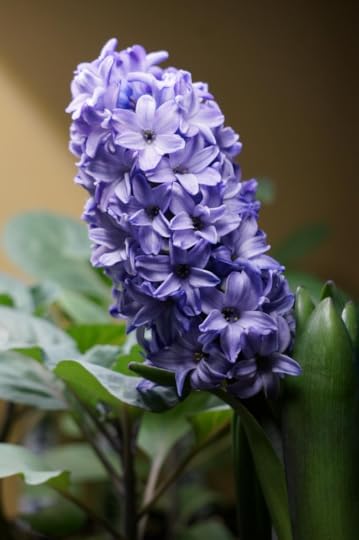
A long time ago, when the gods were still roaming around Earth, there was a young Spartan prince named Hyancinthus.
Hyancinthus was super chill, mega good-looking, and athletic too.
Zeus’ son, Apollo, was completely in love with him.
So was Zephyrus, god of the west wind.
One afternoon, Hyacinthus and Apollo were playing a game of frisbee. In those days, the disc was made of stone. It was super heavy to throw, but these are legendary Spartans and Greek gods we’re talking about.
Apollo threw the discus.
Hyancinthus ran to catch it.
Zephyrus watched. In a moment of jealousy, and being god of the west wind, he blew the stone frisbee off course.
It hit the ground...
“Ha ha ha!” Zephyrus laughed, but then watched in horror as the discus bounced back up, struck Hyancinthus in the head, and killed him instantly.
It was a complete accident.
Apollo was beside himself with grief, trying everything to revive his dead lover.
When none of his advanced medical treatments worked, he even attempted to give Hyancinthus ambrosia to drink.
Ambrosia is the nectar of the gods—an elixir of immortality—and forbidden to mortals.
However, it was all in vain for Hyancinthus was already dead.
Instead of letting Hades take Hyancinthus’ soul to the underworld, Apollo turned him into a flower—the Hyacinth.
And millennia later, the Spartan prince is perfuming my kitchen.
September 19, 2023
Story Time...

By Nhl4hamilton (Rick Cordeiro) - Own work, Public Domain
In a park, overlooking the picturesque Burlington Bay, the British set up a military camp during the War of 1812 as protection against American forces.
In the 1830’s, Sir Allan McNab, Premiere of the United Canadas, built a huge Italian-style villa here.
Think Downton Abbey.
The locals called it Dundurn Castle.
To this day, if you visit my hometown of Hamilton, Ontario, it’s the no. 1 tourist attraction.
Outside the castle was a long aviary. I’d run over to the peacock, begging him to show me his tail.
Sometimes he did.
On the park grounds sat an adorable outdoor theatre called Piccadilly Circus. During the summer, a troupe of performers put on children’s plays. My brother and I would race to the front, flop on the grass in the front row, waiting for the show to start. Sure enough, Hansel and Gretl would come out singing and dancing, pulling me up by the little hands, twirling me around the stage in the opening act.
I knew in my heart when I grew up, I was going to live in Dundurn Castle someday.
One day, I would be the Lady of the House, serving tea from a silver tea pot to my guests.
It was all planned out. I’d buy Dundurn Castle, leave the museum as is, and live there happily ever after.
And...then I grew up.
Alas, Dundurn Castle has never been for sale.
But...
I have cooked in its kitchen several times.
Just call me Daisy because I got to spend the day with my very own Mrs. Patmore.
One blustery winter day, I took part in a recreation of a dinner Sir Allan McNab served in 1855. The original dinner included two soups, one—mock turtle. Instructions included boiling the head of a cow and serving the eyeballs as garnish.
There were ten roasts, eight boiled dishes, six entrees, three relishes, eight second courses, five cheeses, and approximately fifteen desserts.
For our recreation dinner, we only cooked a fraction of the original meal.
Our bill of fare that day was:
Mulligatawny Soup
Roast Duck with Orange Sauce
Chicken Curry after the East Indian Manner
Boiled Beef Tongue
Potato Rissoles
German Carrots
Stewed Red Cabbage
Plain Buns
Indian Pickle
Carrot Pudding with Plum Sauce
Apple Pie
Blanc Mange
Tea & Coffee
That day, I’d be a servant. So, after trudging through the snow to the servant’s entrance, I was escorted down the back stairs. Bypassing all the beautiful rooms. It was straight to the basement for me.
It took a while for my eyes to adjust to the darkness and even then, everything was so dim. The lack of light would have been depressing for anyone, day after day.
Although a museum, inside the kitchen we pretty much had free reign. Everything was useable and old. Cupboards had drawers of rolling pins. Mixing bowls sat on open shelves. We had to keep drinking water so not to become dehydrated while working over the wood burning stove.
A dry sink held two basins of water: one for washing, one for rinsing.
We prepared the dinner at long work tables. When a recipe called for a cup of something, we’d fill a teacup for measurement. If it called for 3/4 tsp of nutmeg, we eyeballed it using regular spoons. The spices were in glass bottles with corks. The good old sniff test was used to find the correct one.
We had to keep our eye on the stove fire, making sure it didn’t go out. Next to it was not only wood...but an entire bucket of baking soda on one side, a pail of water on the other, and a huge blanket hanging on the wall in case someone’s clothing caught fire.
We split into groups to prepare the menu. My friends, Cathy, Joyce and I prepared the Mulligatawny Soup, German Carrots, and Apple Pie.
Nobody wanted to prepare the boiled beef tongue.
“But the taste buds have already been removed,” our Mrs. Patmore reassured us.
So, on with our soup recipe:
”Take two large fowls...cut the flesh entirely from the bones into small pieces...”
Ugh....glance around the table uneasily and then let out a sigh of relief.
Store bought chicken breasts.
Score!
The ingredients required were quite strange. Our soup included tart apples, not potatoes. It was to be served over a bed of rice. A soup? It also included a boatload of curry—a status symbol at the time to show you could afford such faraway spices.
Now, my friend, Cathy, was in her element cooking downstairs in the kitchen, certain she must have been a servant in a past life.
Me...I found myself wandering about the kitchen quite a bit, examining everything, leaving my poor friends to do most of the cooking.
“I think I’d rather be upstairs, drinking tea and doing needlepoint in the parlour,” I‘d joke while taking the long wooden spoon from Cathy to give her a break from the hot stove.
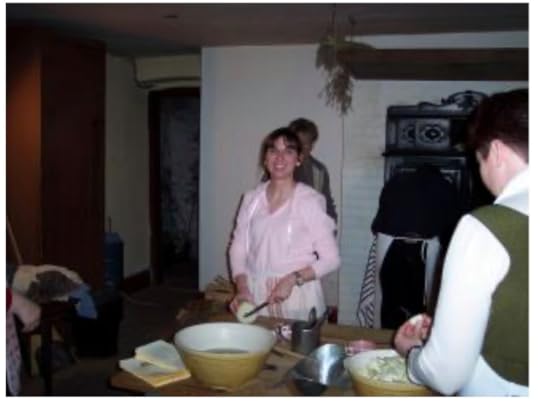
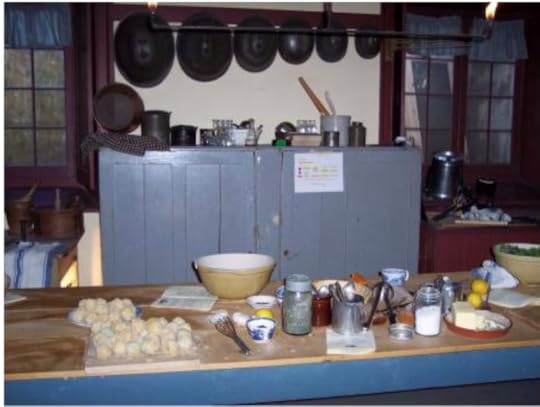
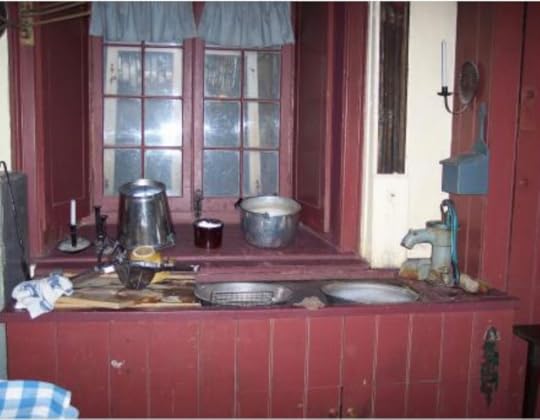
After about three hours, all the food was prepared, ready to be eaten. Since the real dining room is a museum, a make-shift one was set up in the “McGinnis Billards Room.” It was still very beautiful. With ornate mouldings and gorgeous windows, it overlooked a snowy tree-lined walkway leading to the lake. A winter wonderland.
The table was set with white linen and pretty dishes. The first item of the menu was the Mulligatawny Soup we’d prepared. It turned out so awesome that I’ve made it again several times.
I sampled everything, determined to try each item to get the full experience, including the beef tongue. Topped with chutney, it was actually quite delicious.
The flavours were all very different to the food we eat today, even the desserts.
Except for the apple pie.
A good apple pie is always the highlight of any meal.
Then, as fate would have it, I had the honour of being the “Lady of the House”.
My job?
To serve tea to all my guests gathered around the table...from a silver tea pot.
Funny how life works out.
I may not have grown up to live in Dundurn Castle, but the first time I dine there, I’m “Lady of the House” serving tea from a silver tea service. Technically, my childhood wish came true.
Someone up there in the heavens has a great sense of humour.
Interesting Fact of the Day...
Gather round for story time!
Actually...hop into my little golf cart because today I'm taking you to the Palace of Versailles.


We recently stayed at the palace, in the Grand Contrôle, in a suite adorned with whimsical hot air balloons. The fabric covered the walls, the upholstery, the curtains...
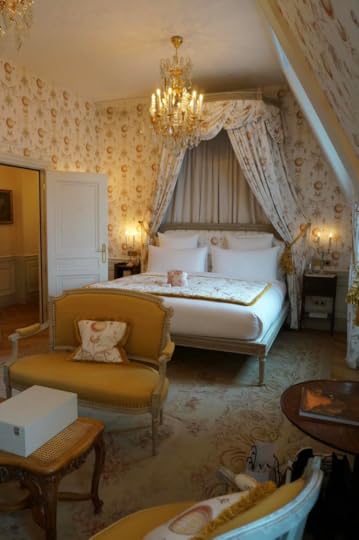
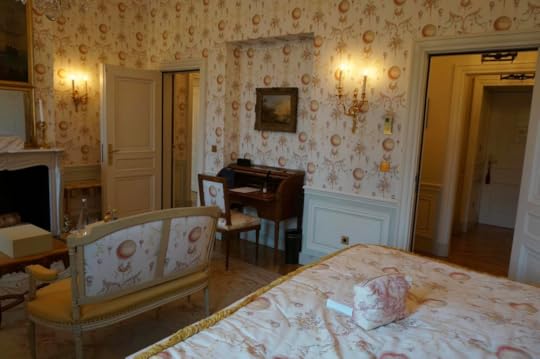
I absolutely loved it.
“Madame, do you know the significance of the hot air balloons?” the butler asked with a grin.
“No! Tell me,” I replied, eagerly awaiting a new tale.
September 19, 1783—
(Oh my gosh…I just realized today is September 19th!)
So, exactly 240 years ago today, the first hot air balloon flight took place.
The passengers?
A sheep, a rooster, and a duck.
The Montgolfier brothers, wealthy paper manufactures, were invited to show off their invention— a hot air balloon—to King Louis XVI and Marie Antoinette.
The king suggested they send prisoners up in the basket, but the brothers suggested the three animals instead.
All morning, the grounds of Versailles filled with curious Parisians, and at 1:00 pm, in front of the Royal Family, a cannon blasted.
The balloon carrying the three animals lifted into the air and took flight, traveling 3.5 km before ripping. It slowly fell from the sky, leaving the animals unharmed.
The 8 minute flight made the history books.
And the sheep, rooster, and duck lived happily ever after in the King’s menagerie.
And there you have it. Your useless but interesting fact of the day.
The first hot air balloon flight.

Photo credit: Chateau de Versailles
Story Time...
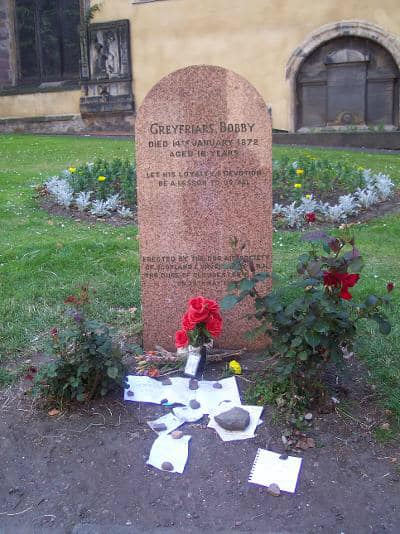
Gather round for story-time. Here’s a beautiful one for all you dog-lovers.
1850’s Scotland.
A gardener named John Gray moved to Edinburgh. Unable to find employment, John took a job as a police constable working as a night watchman.
Everyone called him Auld Jock. (Old Jack)
For several years, Auld Jock was accompanied on his evening route by his faithful little friend—a skye terrier named Bobby. The two were inseparable.
All the locals knew Auld Jock and Bobby—the police constable and his best buddy.
On February 15th, 1858, Auld Jock died.
The funeral procession went through the streets of Edinburgh to the cemetery in Greyfriars kirk yard...with Bobby, the faithful little dog leading the way.
Afterwards, Bobby wouldn’t leave.
He slept on Auld Jock’s grave.
However, dog’s weren’t allowed in the kirk yard.
The caretaker shooed Bobby away, but he’d come back every night to sleep on top of the grave.
Before long, the locals fell in love with loyal Bobby.
Many tried to adopt him, take care of him, lure him away.
Nothing worked.
The dog always came back to Auld Jock’s grave.
Realizing Bobby wasn’t going to leave, the caretaker built a little dog house next to the grave and let him stay.
This went on for years.
Balmoral Castle would set off their one o’clock gun and people would gather outside the kirk yard to watch Bobby. Like clockwork, the little dog would leave the cemetery and walk down the street to the pub he used to go to with Auld Jock.
Every day, the pub owner fed the dog a hearty meal. Bobby would enjoy his feast at the pub before faithfully returning to the grave.
After nine years, a law was passed stating that all dogs must have a license. Any strays would be rounded up and “destroyed”.
A dog catcher rounded up Bobby.
The locals went berserk, determined to save the loyal dog.
Eventually, the Lord Provost of Edinburgh stepped in. He bought Bobby a collar and paid for his license every year.
After FOURTEEN years of watching over Auld Jock’s grave, Bobby himself passed away at the ripe old age of sixteen.
They buried him at the entrance of the kirk yard and gave him his very own headstone. His collar is in the Edinburgh Museum.
In 1872, Baroness Burdett-Coutts had a bronze memorial erected for Scotland’s most beloved and famous dog.
And there’s your interesting fact of the day: Greyfriars Bobby.
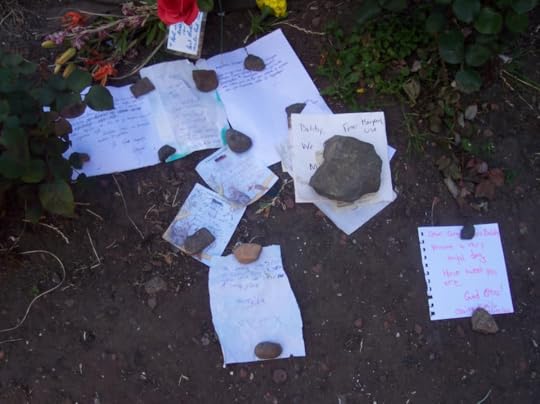
September 18, 2023
Interesting Fact of the Day...

My lovely neighbour gave me some rhubarb from her garden, which made me wonder if you knew about its interesting history...so gather round! It‘s time for Tammy’s fascinating, (but useless) fact of the day.
Rhubarb has been used for at least 5000 years...but only as a medicine. Because the leaves are poisonous, it was not considered “food” for centuries.
In Ancient China, it was used as a laxative, for reducing fever, for dying hair, and for scrubbing pots and pans.
The Ancient Romans imported rhubarb roots from Russian ports along the Volga River, received from suppliers who got it from barbarians in unknown lands.
By the 13th century, Marco Polo travelled to China and wrote about the rhubarb growing there. Because it was considered a “cure-all”, it became an expensive commodity, trading along the Silk Road at prices more expensive than cinnamon and saffron.
But...it wasn’t until the 1800’s when those crazy Victorians began to eat the stalks. And they LOVED it. The first known recipe using rhubarb in a dessert is found in “A New System of Domestic Cookery“ by Maria Eliza Rundell, 1807.
However, when the First World War began, there was a setback in rhubarb popularity. Because it had become a recommended food, the soldiers would eat the poisonous leaves, not knowing it was the stalks that were edible. Many were sickened, at least one known death.
Amazing to think that for centuries nobody in the ancient or medieval world experienced the wonderful taste of a strawberry rhubarb pie, when it was right there all along.
September 17, 2023
Interesting Fact of the Day...

Flowers from my garden
The frilly white flower to the right of the blush-coloured rose is a scabiosa.
Scabiosa?
Why-oh-why does such a lovely flower have such an ugly, unromantic name?
Turns out it was used in medieval days by apothecaries to treat the bubonic plague, snake bites, and skin conditions like--you guessed it---scabies.
And there you go.
Your useless, but interesting, fact of the day.
The beautiful scabies flower.



